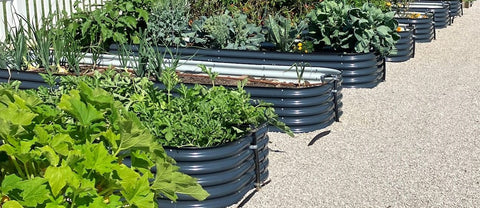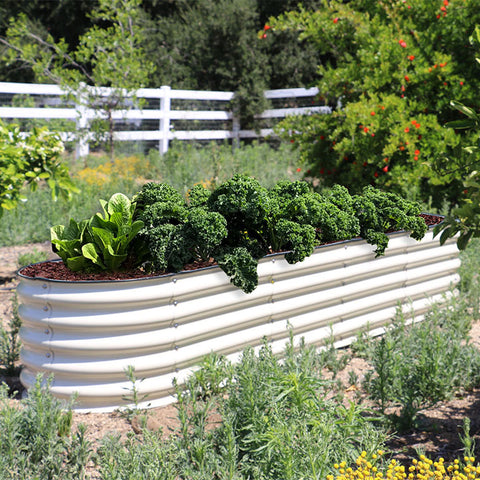Tips from Olle Garden Bed: 10 Plants That Can Lead To Skin Reactions On The Homestead
The natural tendency is to want to skim through a list of plants you should avoid by merely looking for the most obvious ones. For example, poison ivy is usually marked with three leaflets per leaf and big, fat berries. However, there are many plants that can cause skin irritation without being so obvious. The following content also has some reference value for raised garden beds.
While you're hopefully not dealing with many of these plants on a daily basis, your family members or pets might get into them. Make sure that you are familiar with them and keep them away from your homestead as much as possible. If you're going to be in contact with any of the listed plants more often, it's an excellent idea for you to wear protective clothing like gloves to avoid discomfort. Another thing to keep in mind is that many of the plants on the list will cause burning reactions when they come in contact with eyes, noses, and mouths. So make sure that you, your family members, and your pets stay away from these plants.

- Poison ivy
This is probably the most common irritant plant and the easiest to identify. Poison ivy grows all over the United States, and if you spend time outdoors, you're likely to encounter it on a regular basis. You may see three different species in the United States: Toxicodendron radicans, T. rydbergii, and T. orientale.
Poison ivy contains a chemical called urushiol, which is found throughout the plant, including leaves, roots and flowers.
One of the annoying things about poison ivy is that skin irritation can appear for days or even a week after you are exposed. This confuses you, and you might not associate the problem with when you encounter plants outside.
If you touch plant parts, or even someone or something, you will experience increased itching, redness and swelling, and sometimes blisters.
Topical or corticosteroid creams may help, or your doctor may prescribe medication if you have a severe reaction.
Identify poison ivy:
Poison ivy grows in suburban backyards, homesteads, roadsides, and almost anywhere the land is disturbed. It grows in a climbing habit or along a path along the ground.
Poison ivy loses its leaves in the fall, but the plant is still an irritant without leaves, which will grow back in the spring.
They have three compound leaf clusters. Remember the saying: Three leaves, let nature take its course. The middle leaf has the longest stem.
- Venom
This is another common plant in the United States that also contains urushiol. Usually found in the environment around water such as ponds, wetlands and streams. You can find it anywhere, especially in heavy clay.
It can cause skin irritation through contact, but as with all urushiol-containing plants, you must break the leaves, stems, or roots to be exposed. Passing by plants is not going to work.
In some people, poison sumac can be more toxic than poison ivy.
Identify toxic sumac:
Poison sumac trees, sometimes called Toxicodendron vernix, grow like small trees or shrubs.
It can be identified by the red stems that fall off the plant's trunk, and has up to 13 glossy green leaves. The flowers are pale yellow with a green tinge and the berries are dark grey.
- Poison oak
In addition to our three urushiol-containing plants, you can also find Toxicodendron diversilobum in dry areas and forest locations.
Also, keep in mind that some people aren't affected by urushiol, and until they come into contact with the affected person, they won't realize they've been in these things all along. Then, that person will break out in a rash because urushiol can spread on skin, clothing, or tools.
That's why you really need to identify and eliminate these things. Don't burn it, though! Burning plants that contain urushiol releases toxins into the air that can damage your lungs.
Identify Poison oak trees:
Poison oak trees have hairy yellow flowers and berries covered in a light fuzz. It can grow as a large woody vine or woody shrub. It is a deciduous plant, but beware. Even leafless branches and stems can cause severe skin irritation.
Leaves in clusters of three, dark green. They look a bit like English oak, although they are not related.
It is difficult to identify all the poisonous plants on this list in winter because the leaves are not present. This is why you should do your best to check them and remember where the patches were on your property when the leaves were present.
- Wood nettles
If you wander around wet woodland areas, you may encounter wood nettles (Laportea canadensis). Common in cool, damp areas of homesteads. It doesn't grow in the western United States.
Many people eat wood nettles by frying them. Always wear gloves when collecting plants.
Of all the stinging plants, I find wood nettle the easiest to work with. If washed with soap and water, the effect can be reduced. But keep in mind that these plants affect people in different ways, so the best thing to do is avoid them if possible.
Identify wood nettle:
Wood nettles tend to grow in medium to large patches, making them easy to spot. The stems are about four feet tall and are covered with stiff hairs that sting when you touch them or just rub them.
The leaves are serrated and dark green, sometimes light green. The young leaves have a lot of hair, and in summer you'll see wisps of white flowers.
- Lead grass
Ceratostigma plumbaginoides is a common plant that many people use as ground cover in their gardens. It looks nice, but don't touch it.
Also known as lead grass, lead grass is common in the southern United States.
Wear gloves when handling the plant, as skin irritation is common, as well as redness and blistering.
Identify lead grass:
The plant grows up to 10 inches tall and is deciduous or semi-evergreen. The leaves turn red in autumn and gentian flowers bloom in spring and summer.

- Giant hogweed
Have you ever looked at an overgrown area and thought you were just starting to get rid of weeds? Giant hogweed (Heracleum mantegazzianum) is likely to be among the plants there. It is common and is considered a harmful weed that has invaded North America.
The plant has a SAP inside that can irritate your skin and cause serious damage to your eyes, which can lead to blindness. Seriously: you have to keep the juice away from your skin and eyes.
Blistering and scarring are common, and scars actually look like burned skin. You may also end up being sensitive to sunlight.
Giant hogweed is a so-called phototoxic plant. It needs ultraviolet light to burn your skin. More precisely, it prevents your skin from protecting itself from the sun. If you touch the plant by mistake, keep it out of direct sunlight until it can be cleaned with soap and water. Better yet, stay out of the sun for 48 hours after washing.
Identify giant hogweed:
Giant hogweed grows very tall. It is known to reach a height of 14 feet. The stem is hard and hollow, with white hairs. Leaves can be five feet wide. It has large clusters of white flowers.
- Stinging nettles
Although nettle tea and many recipes are great, stinging nettle (Urtica dioica) can be a pain anywhere on your homestead.
Unlike other plants we've looked at, rashes appear almost immediately and may include raised bumps that look like hives.
Some people may even have an allergic reaction, which should be treated as a medical emergency.
For most of us, the best thing to do is to let the pain-causing chemicals dry, so leave the area alone for about 10 minutes. Then, wash with soap and water, but avoid scrubbing too hard, as you may push the toxins deeper or spread them to other parts of the body.
Identify stinging nettle:
You will often find stinging patches of nettles in wet and humid areas, especially near streams, or in wooded areas with thick canopies.
The stems and leaves are covered with small hairs. These are hollow, and when the plant comes into contact with your skin, chemicals flow through these hairs, causing instant stinging and rashes.
These plants are five feet tall and have opposite leaves. Leaf apical, margin densely toothed.
- Ragweed
Ragweed, a plant in the genus Ambrosia, contains a lot of pollen and is often blamed for hay fever symptoms. They can also cause rashes in people who are allergic to pollen. Exposure occurs when airborne pollen is inhaled, or when a person touches a plant and gets pollen on their skin.
Identify ragweed:
Pollen is located at the top of the plant and flowers grow like spikes or streamers. The leaves are medium green. The leaves almost look like ferns, with fine hairs.
- Natural gas plants
Fraxinella (Dictamus albus) is an herb grown by many people, but when the SAP comes into contact with the skin and is exposed to sunlight, the SAP can cause severe skin irritation in some people.
Many people love the scent of flowers and citrus, but just letting plants rub against their skin can cause a nasty rash.
Identify natural gas plants:
The plant itself grows about 40 inches tall and has spikes of purple or white flowers. The leaves look similar to those you would find on an ash tree.
- Wild parsnips
The tall plant (Pastinaca sativa) has small yellow flowers and contains a SAP that causes a painful rash when it touches the skin and is exposed to sunlight. It takes about 24 hours to notice symptoms, but then they appear quickly.
Localized burning can be very intense and then forms a rash, often blistering. The affected skin's sensitivity to sunlight can last up to two years.
Wild parsnips have edible roots and are a sought-after plant for some people, but the rest of the plant is poisonous. It's definitely best left to experienced foragers. The rest of us should avoid it at all costs.
Identify wild parsnips:
Wild parsnips can grow up to six feet tall when they bloom, which happens in their second year. It looks similar to Queen Anne's lace and has a hollow stem. The leaves are ovate and become smaller near the top of the stem.

How can you protect your skin from irritating plants
The list of plants that can cause skin irritation just by touching them is long, as we are all different and sensitive to different things. The list above includes the most common plants that cause skin irritation to almost everyone who comes into contact with them.
While you should aim to remove these irritants from your property, here are some ways to protect yourself while you're out and about or removing them:
Wear protective clothing for your arms and legs. Most of us have garden gloves to protect our hands, but we often forget about our forearms and legs.
Wear safety glasses when removing common plants that cause skin irritation. Many of these contain SAP that can cause irritation or even blindness if it gets in the eye. Bringing plant hair into your eyes can also cause severe irritation and pain.
Wash your gardening clothes. Many of the compounds in these plants will sit on the surface of your clothes, just for you or someone else to touch them and get it on their skin. Consider working near these plants or washing your clothes directly after removing them, even if you are gardening in a new set of clothes.
If you are particularly affected by these plants, ask someone else to remove them.
